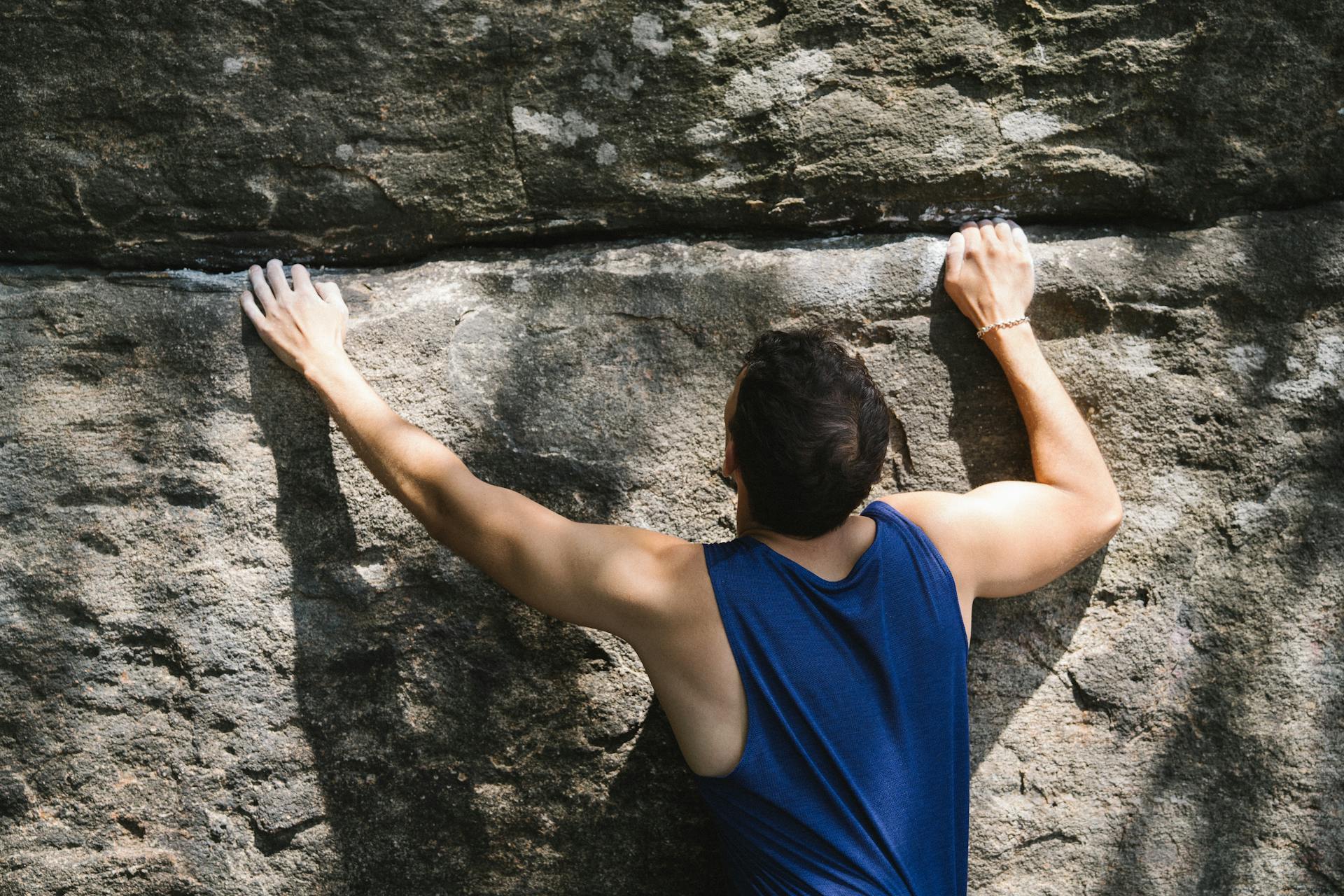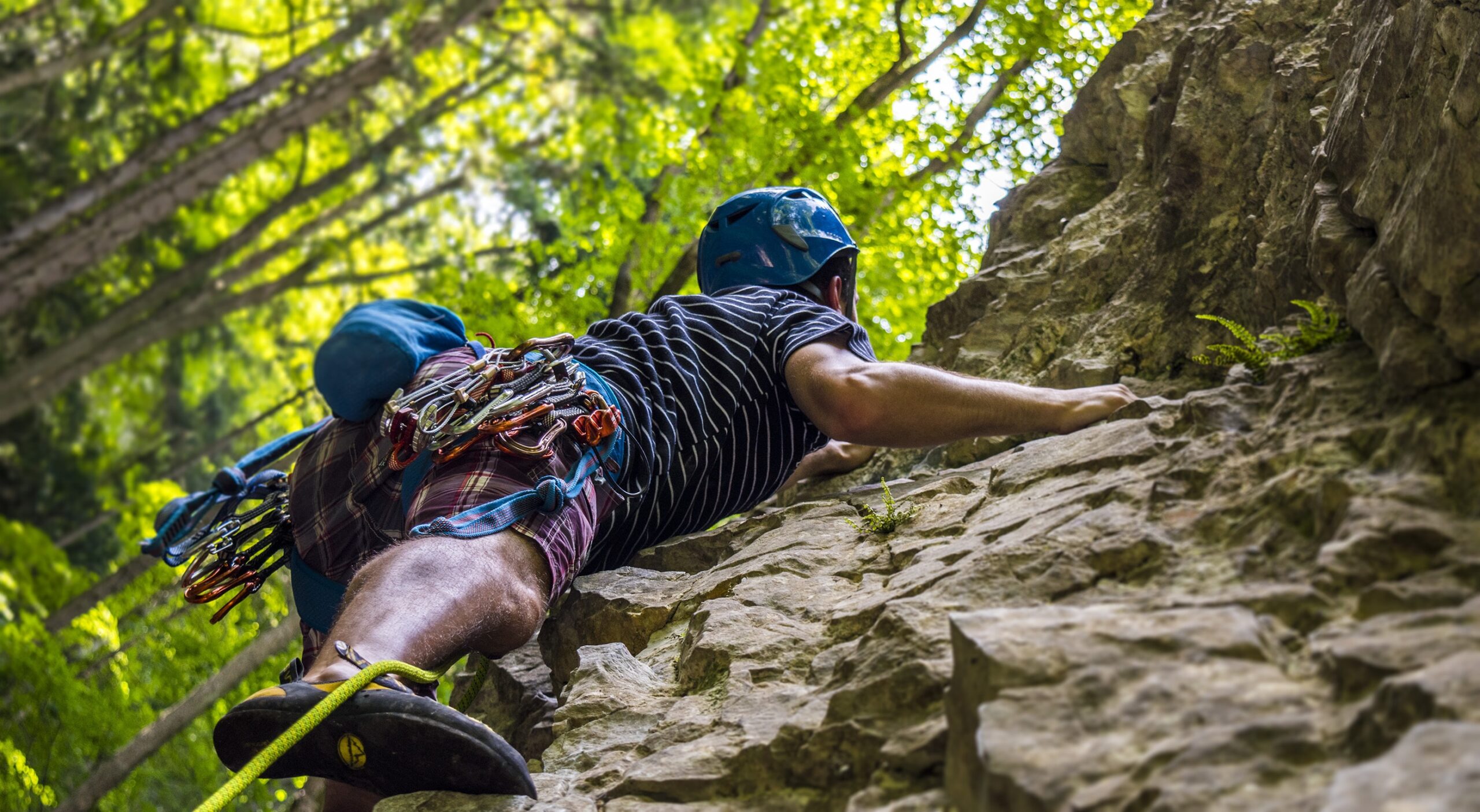Rock climbing pushes both your physical and mental limits. It combines strength, endurance, and Rock Climbing Technique. While having strong muscles helps, refining your climbing techniques is key to climbing safely, efficiently, and enjoying the process. Here, we’ll cover three essential techniques: footwork, handholds, and body positioning. Footwork is a cornerstone of climbing techniques. Proper footwork saves energy and improves balance, allowing smoother, more controlled movements. Precise foot placement lets you climb higher while conserving strength. This involves wearing the right climbing gear, paying attention to your feet, and trusting them to hold your weight. Strong footing is the foundation for better climbing performance and safer climbing.
Handhold techniques are another major factor in Rock Climbing Technique. Knowing how to grab and use different holds like crimps, slopers, and jugs can determine your success on a route. Each type of hold requires specific grip strength and pressure. Mastering these grips helps you climb further while using less energy. Understanding handholds also builds confidence and improves overall efficiency. Body positioning ties everything together. Proper positioning balances your weight distribution and reduces strain on muscles. Keep your hips near the wall and distribute your weight evenly for better balance. Managing your center of gravity allows smoother movements and increases endurance for tougher routes.
Many overlook this, but it’s crucial for safe and effective climbing. Combining footwork, handholds, and body positioning creates a solid climbing foundation. Regular practice strengthens these techniques, leading to better results and a more enjoyable experience. With time, you’ll see improvements in strength, flexibility, and confidence. Whether climbing indoors at a climbing gym or exploring outdoor climbing routes, focusing on these basics will help you grow as a climber.

For better progress, incorporate a climbing training plan. Add climbing exercises like strength training, grip work, flexibility training, and endurance training into your routine. Practice moves like edging, smearing, flagging, dynos, mantling, toe hooks, and heel hooks to refine your skills. Mental training and risk assessment are just as important to stay safe and prepared. Before climbing, perform a gear check, review belaying techniques, and ensure knots are secure. Learn about the fall factor and always assess risks. Joining a climbing community or attending climbing events and climbing competitions can help you gain experience and connect with others. Whether indoors or outdoors, staying safe with climbing safety tips and learning from others will enrich your climbing journey.
Footwork: The Foundation of Climbing
Footwork techniques are the unsung hero of climbing; it can make the difference between a successful ascent and a frustrating fall. Rather than simply stepping onto a foothold, actively reach for it with your foot, ensuring that your placement is precise and deliberate. This attention to detail is crucial in maintaining both balance and control. Before you step, take a moment to assess the foothold and visualize where you want to place your foot. This mental preparation helps in executing a smooth and confident movement. When positioning your foot, aim for the center of the foothold to maximize stability and distribute your weight evenly across your foot. This technique not only enhances your balance but also allows for greater efficiency in your movement.

Maintaining even pressure is essential to climbing effectively. Distributing your weight evenly between your feet helps you maintain balance, reducing the risk of unnecessary strain on your ankles and legs. Additionally, actively pushing down with your toes can drive your body upward, which significantly reduces your reliance on arm strength. By focusing on your footwork techniques, you will find that your arms can conserve energy, allowing for a more sustainable climb.
There are several advanced foot placement techniques that can greatly enhance your climbing efficiency. Edging involves stepping on the edge of your shoe, which provides better leverage on small holds. This technique is particularly useful when navigating challenging routes. Smearing, on the other hand, requires using the entire sole of your shoe to stick to sloped or rounded surfaces, enabling you to make the most of less-than-ideal footholds. Finally, hooking is a technique where you place your heel or toe on a hold for added support, often employed on overhangs. Mastering these techniques will not only improve your climbing performance but also foster a deeper connection with the rock.
Handholds: Grip and Efficiency
Handhold techniques are crucial for mastering Rock Climbing Technique and enhancing performance. Understanding hold types is essential. Crimps are small, shallow holds that demand significant finger grip strength, making them some of the most challenging grips for climbers. Jugs, on the other hand, are large, comfortable holds that are easy to grip, providing a much-needed respite during a climb. Slopers present a different challenge altogether; these rounded holds offer little to no grip and rely heavily on friction and body tension to maintain a secure hold. Lastly, edges are flat or semi-flat holds that require precise edging technique, as improper foot placements can lead to slips and falls.

Effective hand placement and grip technique are essential for climbing efficiency. Matching, or placing both hands on the same hold, can be an effective strategy for resting or conserving energy. When tackling slopers, climbers should focus on utilizing friction and body tension to ensure a stable grip. For crimps, it’s vital to minimize finger pressure to conserve energy and reduce the likelihood of injury, allowing for longer climbs without fatigue.
A climber’s ability to coordinate hand and foot movements plays a significant role in overall climbing success. Smooth transitions between hand and foot placements help maintain balance and efficiency. Avoiding overreaching is crucial, as extending too far can lead to instability and wasted energy. Instead, climbers should focus on foot-driven movement, using their feet to propel themselves upward whenever possible, which significantly reduces the strain on their arms and enhances overall climbing efficiency. This synergy between handholds and movement ultimately leads to improved performance and enjoyment in climbing.
Body Positioning: Center of Gravity and Efficiency
Maintaining an optimal center of gravity is essential for effective climbing. It is crucial to stay as close to the wall as possible, which helps preserve stability and maximizes efficiency during your ascent. When you position your center of gravity near the wall, you can distribute your weight more evenly, making it easier to navigate challenging sections. On the contrary, leaning back can disrupt your balance, complicating your movements and increasing the difficulty of your climb. It is vital to remain mindful of your posture; adopting a relaxed and fluid position allows for smoother transitions and helps conserve energy, reducing the risk of fatigue.

Engaging your core muscles is another critical aspect of maintaining stability and proper body positioning while climbing. A strong core supports your movements and helps you stay aligned, which is particularly important on overhangs and vertical routes. However, it’s equally important to avoid unnecessary tension in your body. Try to relax the muscles that are not actively engaged in the climbing process, as this will aid in conserving energy and improving your overall performance.
Identifying and utilizing resting positions is a valuable skill for climbers. Learning to recognize these spots allows you to recover and conserve energy effectively. When you find a good resting position, take a moment to relax your muscles and catch your breath. This strategic use of rest can significantly enhance your endurance, enabling you to tackle more challenging sections of your climb with renewed strength and focus. Embrace the power of positioning to elevate your climbing experience.

Practice and Refinement
Practice and refinement are crucial elements in the journey of becoming a proficient climber. Starting small is a solid approach to foster growth in your climbing ability. Embarking on easy climbs initially allows you to build a solid foundation and comfort level before advancing to more challenging ascents. Gradually increasing the difficulty as your skills improve is a natural progression that keeps you engaged and motivated in your climbing pursuits. Moreover, focusing on climbing techniques is paramount in your climbing endeavors. Rather than prioritizing speed or difficulty, placing emphasis on proper form and technique ensures a solid foundation and minimizes the risk of injury. Perfecting your Rock Climbing Technique can enhance your overall performance and make climbing more efficient and enjoyable. Remember, Rome wasn’t built in a day, and neither is a strong climbing technique.

Seeking guidance from a qualified climbing instructor can provide invaluable insights and support on your climbing journey. Investing in lessons allows you to learn from a seasoned expert who can tailor their teaching to your specific needs and help you overcome any obstacles you may encounter. A skilled instructor can offer personalized feedback and suggestions that can accelerate your progress and take your climbing skills to new heights. Furthermore, observing experienced climbers in action can be a great learning opportunity. By closely watching how proficient climbers navigate routes and employ different techniques, you can glean valuable insights and tips that can enhance your own climbing abilities. Pay attention to the subtle nuances of their movements and strategies, and try to incorporate these learnings into your own practice sessions.
Consistent practice is the bedrock of improving your Rock Climbing Technique and developing muscle memory. Regularly dedicating time to climb not only helps you hone your skills but also builds your physical strength and endurance. Repetition is key to solidifying your understanding of climbing movements and techniques, allowing you to perform them with greater confidence and precision. In conclusion, by embracing the principles of starting small, focusing on technique, seeking guidance, observing experienced climbers, and practicing regularly, you can embark on a fulfilling climbing journey filled with growth, improvement, and enjoyment. Remember, progress in the climbing is a gradual process, so be patient with yourself, stay persistent, and celebrate the every milestone along way.

Conclusion
Mastering Rock Climbing Technique deeply engages practitioners in a perpetual cycle of learning, experimentation, and fine-tuning. By honing their skills in the art of precise foot placement, strategic handhold utilization, and perfecting body alignment, climbers not only enhance their performance capabilities but also significantly diminish the likelihood of potential injuries, fostering a safer and more sustainable climbing experience. It is within this intricate process of deliberate practice that climbers can uncover a profound admiration for the complexities and nuances of this exhilarating sport, cultivating a sense of awe and respect for the mountains they conquer and the challenges they overcome.
Furthermore, the path to climbing excellence is paved with unwavering dedication, steadfast patience, and a voracious appetite for assimilating knowledge from every ascent and setback. Embracing the mindset that growth comes not only from triumphs but also from setbacks is paramount in the journey towards achieving one’s highest potential in rock climbing. Therefore, it is essential to approach each climb with a sense of purpose, imbuing every movement with intentionality and thoughtfulness, thereby allowing oneself to fully connect with the rock and experience the profound joy of ascension.
As climbers venture upwards, they encounter a multitude of obstacles that test their physical and mental fortitude, pushing them to their limits and propelling them into realms of unparalleled self-discovery and personal growth. Every ascent serves as a testament to the inner strength, resilience, and unwavering determination that are necessary for conquering not only the rocky terrains but also the limitations of the mind. By persisting through the challenges, climbers not only reach new heights in their skill levels but also attain a deeper understanding of themselves, uncovering hidden reservoirs of courage and willpower that lie dormant until summoned by the unyielding demands of the climb.
The pursuit of excellence in rock climbing is a holistic journey that transcends the realms of mere physical skill, encompassing emotional resilience, mental acuity, and spiritual fulfillment. By embracing the trials and triumphs of the climb with open arms, climbers can unlock the true essence of their being, standing on the precipice of greatness and gazing out at the vast expanse of possibilities that unfold before them. So, let every climb serve as a testament to your unwavering resolve, a celebration of your indomitable spirit, and a reminder of the boundless potential that resides within each and every one of us.




